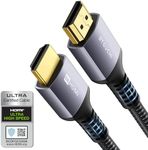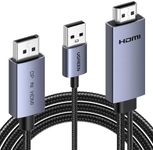Buying Guide for the Best Hdmi Cables
When choosing an HDMI cable, it's important to understand that not all cables are created equal. The right HDMI cable for you will depend on your specific needs, such as the type of devices you're connecting, the resolution and refresh rate you want to achieve, and the distance between your devices. By understanding the key specifications of HDMI cables, you can make an informed decision that ensures optimal performance and compatibility with your equipment.HDMI VersionThe HDMI version indicates the capabilities of the cable in terms of bandwidth and supported features. Newer versions, like HDMI 2.0 and HDMI 2.1, support higher resolutions and refresh rates, as well as advanced features like HDR and eARC. If you're connecting modern devices like 4K TVs or gaming consoles, you'll want a cable that supports at least HDMI 2.0. For future-proofing and the best performance, HDMI 2.1 is recommended, especially if you're interested in 8K content or high refresh rates for gaming.
Cable LengthCable length is important because it affects signal quality. Longer cables can experience signal degradation, especially if they are not well-shielded. For most home setups, a cable length of up to 10 feet is sufficient and maintains good signal quality. If you need a longer cable, consider using an active HDMI cable or a signal booster to ensure the signal remains strong. Choose a length that comfortably reaches between your devices without excess slack, which can cause clutter and potential tripping hazards.
BandwidthBandwidth refers to the amount of data the cable can transmit per second. Higher bandwidth allows for higher resolutions and refresh rates. For example, HDMI 2.0 cables support up to 18 Gbps, which is sufficient for 4K at 60Hz, while HDMI 2.1 cables support up to 48 Gbps, allowing for 8K at 60Hz or 4K at 120Hz. Consider your current and future needs; if you plan to upgrade your devices or want to ensure compatibility with the latest technology, opt for a cable with higher bandwidth.
Build QualityThe build quality of an HDMI cable affects its durability and performance. Look for cables with good shielding to prevent interference, and connectors that are gold-plated for better conductivity and corrosion resistance. A well-built cable will last longer and provide a more reliable connection. If your setup involves frequent plugging and unplugging, or if the cable will be in a high-traffic area, prioritize a robust build to withstand wear and tear.
CompatibilityCompatibility ensures that the HDMI cable works with your devices. Check the specifications of your devices to ensure they match the capabilities of the cable. For example, if your TV supports 4K HDR, make sure the cable is rated for that. Also, consider any additional features you might need, such as Ethernet over HDMI or ARC (Audio Return Channel), and ensure the cable supports these features. Compatibility is key to ensuring you get the most out of your devices without any connectivity issues.


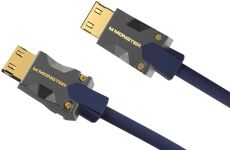

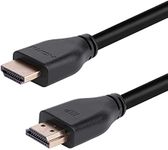

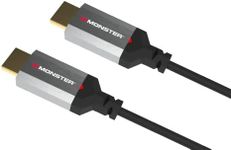

![[Ultra High Speed HDMI Certified] C](https://images-proxy.bestreviews.guide/bnV3_tmuGyV3ugwNz7SNoNgxMgI=/0x150/https://m.media-amazon.com/images/I/41NHun8Y7LL._AC_CX679_.jpg)


